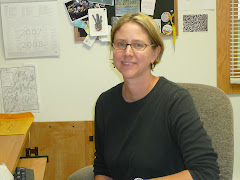
A trip to beautiful Mount Broč near Maribor yielded an interesting limestone topography, unusual plants typically found closer to the Mediterranean, and quite a few of the predacious, pit-building ant lion larvae that I am studying with Dušan Devetak. As we drove up into the mountain amid the luscious green vegetation, the grass hung over where the road cut into the side of the hill. This is where the small, symmetrical pits of the ant lions are to be found -- under the grassy overhangs, where the soil is dry and sandy. The most common species,
Euroleon nostros 
(Neuroptera Myrmeleontidae), was found at frequent sites along the road. To find the second ant lion species,
Myrmeleon formicarius, my son, Caleb, Dušan, and I hiked along a beautiful path with huge beech trees and wonderful views of the valley. The larvae were found on a hillside about 20 minutes along the path.
They were very cryptic and, according to Dušan, not as common as they used to be. We only found a few of this species before heading back. These larvae will be used in our substrate choice experiment. Right now we have the larvae set up in separate cups and

are feeding them one ant per day for 5 days. We will then starve them for a few days before putting them into the substrate choice “cakes”. Next week I will report on how the experiment is going!
 I am back in Maine after a busy last few weeks in Maribor wrapping up my responsibilities at the University, closing bank accounts and packing up the family. What an amazing experience we have had. The last week of classes I attended an evening talk and was surprised by the Dean with nice words of appreciation for my visit and a beautiful Slovenian pottery bowl and book. I really appreciate their efforts to make me feel welcome and valued.
I am back in Maine after a busy last few weeks in Maribor wrapping up my responsibilities at the University, closing bank accounts and packing up the family. What an amazing experience we have had. The last week of classes I attended an evening talk and was surprised by the Dean with nice words of appreciation for my visit and a beautiful Slovenian pottery bowl and book. I really appreciate their efforts to make me feel welcome and valued.

 (Neuroptera Myrmeleontidae), was found at frequent sites along the road. To find the second ant lion species, Myrmeleon formicarius, my son, Caleb, Dušan, and I hiked along a beautiful path with huge beech trees and wonderful views of the valley. The larvae were found on a hillside about 20 minutes along the path.
(Neuroptera Myrmeleontidae), was found at frequent sites along the road. To find the second ant lion species, Myrmeleon formicarius, my son, Caleb, Dušan, and I hiked along a beautiful path with huge beech trees and wonderful views of the valley. The larvae were found on a hillside about 20 minutes along the path. 





 visit the Stephansdom, which would be recognizable to most of you. It is probably the most recognizable structure in Vienna. The cathedral was built in the 12th century and is built in the Gothic style. It was incredible to be there – quietly looking up at the high ceilings, the famous pulpit, the tiled roof and the crucifixes. A marvelous choir was practicing for a concert that evening – the whole scene was magical.
visit the Stephansdom, which would be recognizable to most of you. It is probably the most recognizable structure in Vienna. The cathedral was built in the 12th century and is built in the Gothic style. It was incredible to be there – quietly looking up at the high ceilings, the famous pulpit, the tiled roof and the crucifixes. A marvelous choir was practicing for a concert that evening – the whole scene was magical.
 Students from the class listening.
Students from the class listening.









